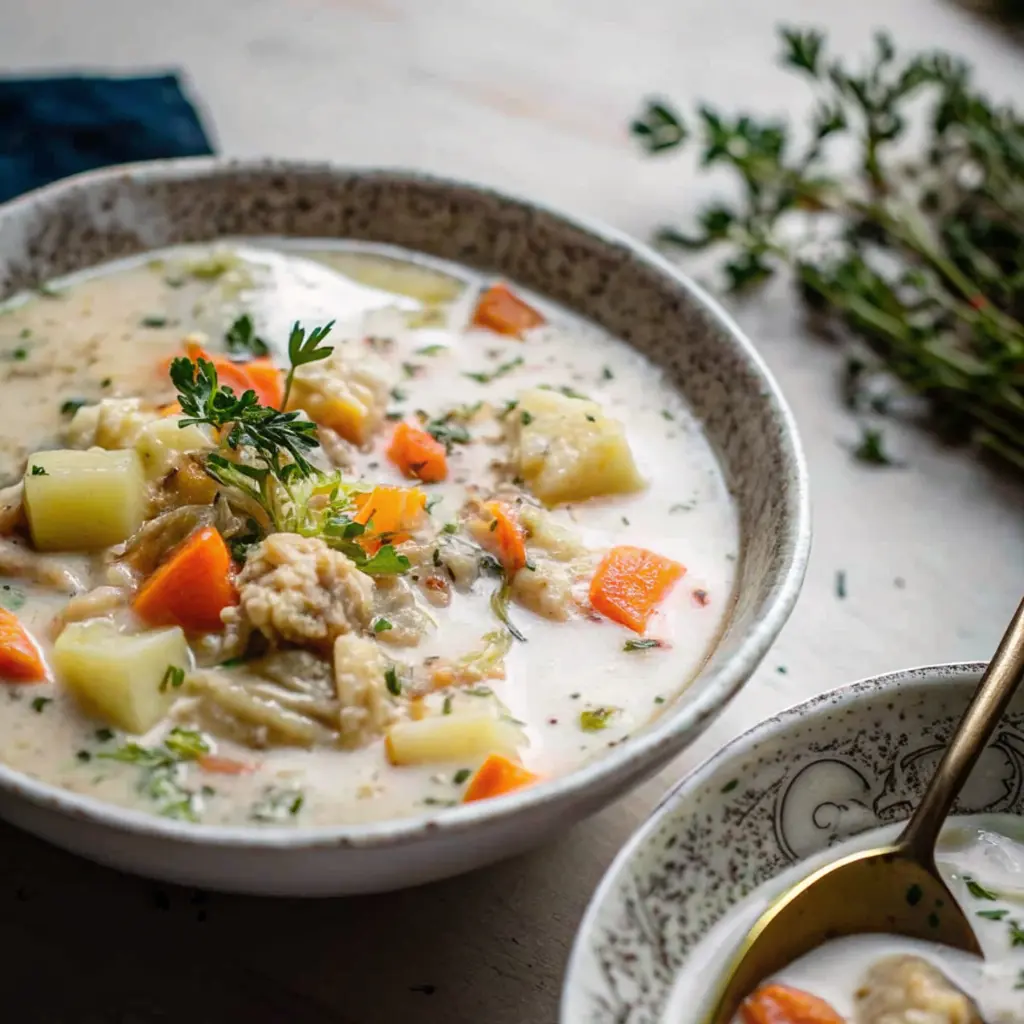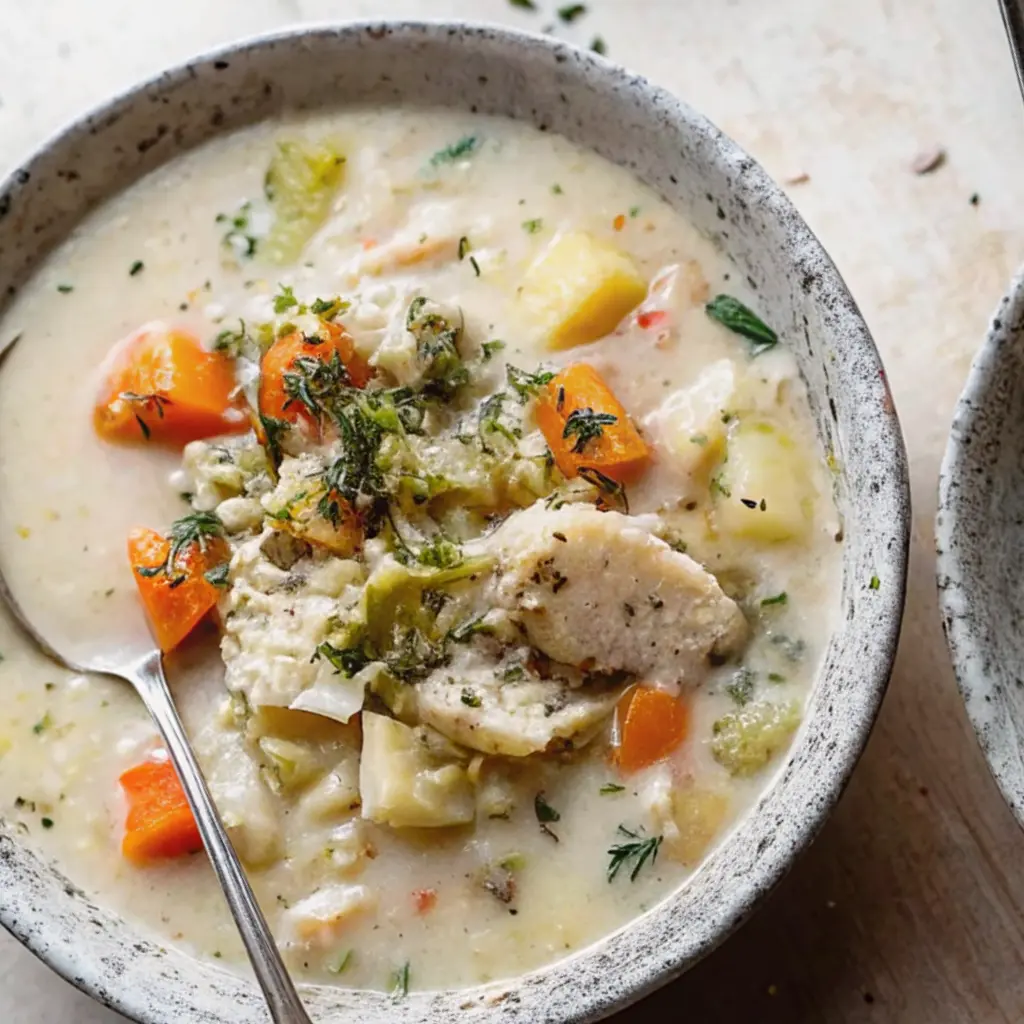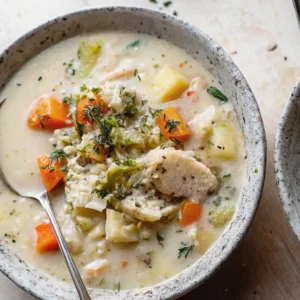It was one of those biting winter afternoons when the wind rattles the windows and makes you wonder if it’s worth stepping outside at all. I’d just come back from the market with a sack of potatoes—big, knobby ones still dusted with soil—and a few onions. The rest of my kitchen looked a bit bare, but I knew what that meant: it was a perfect potato soup day. This soup isn’t something I learned from a book or a video. It was born from a stretch of days when we were counting every penny and needed dinners that could warm us without emptying the pantry. Over the years, I’ve made it richer, creamier, lighter, chunkier, smoother—depending on the mood and the cupboard. But no matter the variation, it always tastes like home, and it’s the one recipe my grown kids still request when they visit.

Why You’ll Love This Recipe:
- Simple, affordable ingredients you probably have on hand.
- Cozy, creamy texture that’s deeply satisfying.
- Easy to adapt for different diets and tastes.
- Freezes and reheats beautifully for future meals.
- A true one-pot wonder with minimal cleanup.
Ingredients You’ll Need:
- Potatoes – I usually reach for russets because they break down into a lovely creamy base, but Yukon Golds give a buttery flavor I also adore. I’ve even mixed varieties when that’s what I had.
- Onion – A yellow onion works well, but I’ve swapped in sweet onions or even a handful of shallots when they were hanging around.
- Celery – It adds a subtle freshness that balances the richness. Don’t skip unless you truly must.
- Carrots – A couple of medium ones for color and sweetness.
- Garlic – I like to mince it fresh right before it hits the pot for the fullest flavor.
- Butter – For sautéing and building flavor. If you’re dairy-free, olive oil works fine, though you’ll miss some of that silky richness.
- All-purpose flour – Just a bit, to help the soup thicken without relying solely on potatoes.
- Chicken or vegetable broth – Either works; homemade is lovely but store-bought is perfectly fine.
- Milk or cream – Whole milk gives a nice balance, but cream will take it to the next level. For a lighter soup, use half-and-half or even unsweetened oat milk.
- Salt and pepper – Adjust along the way; potatoes can handle more seasoning than you might think.
- Fresh parsley or chives – Optional, but they brighten the final bowl beautifully.
How to Make It (Step-by-Step Instructions):
Start by peeling and dicing your potatoes into even chunks—about an inch works well. I’ve learned the hard way that cutting them too small makes them disappear into mush before you know it. In a large heavy-bottomed pot, melt your butter over medium heat. Toss in the diced onions, celery, and carrots, and let them soften slowly. This is not a rush job; give them a good 8–10 minutes so the onions turn translucent and sweet rather than harsh. Add the garlic and cook for just a minute until fragrant.
Sprinkle in the flour and stir, letting it cook for a minute to lose that raw taste. This step is small but important—skip it, and your soup might taste a bit “off.” Slowly pour in your broth while stirring, scraping up any bits stuck to the bottom. Once it’s all in, add the potatoes and bring the mixture to a gentle boil. Reduce the heat, cover, and let it simmer until the potatoes are tender, about 15–20 minutes.
Now comes the choice: chunky or smooth? I like a bit of both. I’ll take a potato masher and gently crush some of the potatoes right in the pot, leaving enough pieces for texture. Stir in your milk or cream, taste, and adjust seasoning. Sometimes I find it needs more salt than I expect, so don’t be shy. Let it warm through for another few minutes, then ladle into bowls and top with parsley or chives if you like.

Expert Tips for the Best Results:
Patience is your friend here. Rushing the vegetables at the start will rob your soup of depth, and boiling too vigorously can make the potatoes break down unevenly. Taste at every stage—potatoes are like little sponges, and they’ll soak up more salt than you think. And don’t fear a little butter or cream; this is comfort food, and it should taste like it. If you want it thicker, mash more potatoes. If you prefer it thinner, splash in more broth. Let the soup be what you need that day.
Variations & Substitutions:
This soup has been my kitchen chameleon. I’ve stirred in cooked bacon for smoky depth, swapped in leeks for onions on spring days, and once made it with sweet potatoes when I realized too late I’d bought the wrong kind. I’ve added corn for sweetness, shredded rotisserie chicken for protein, and even kale when I was feeling virtuous. One of my favorite “happy accidents” was using leftover mashed potatoes in place of some of the diced ones—it made for the creamiest, fastest version yet.
Serving Suggestions:
I often serve this with a crusty loaf of bread, still warm from the oven, because there’s nothing better than mopping up the last bits from the bowl. A simple green salad with a sharp vinaigrette balances the richness nicely. It’s equally at home as a starter for a dinner party or as the main event on a cold Tuesday night. If you’re feeding a crowd, set out toppings like shredded cheese, scallions, crumbled bacon, or even a dollop of sour cream so everyone can make their own perfect bowl.
Storage & Reheating Instructions:
In my house, this soup rarely lasts beyond two days, but when it does, I store it in an airtight container in the fridge. The flavors deepen overnight, making the second bowl even better than the first. For reheating, warm it gently on the stovetop over low heat, adding a splash of broth or milk if it’s thickened too much. Freezing works well too—just cool it completely, portion it out, and thaw slowly in the fridge before reheating. The texture might be a touch less silky after freezing, but the flavor holds beautifully.
Recipe FAQs (Answered by Clara):
Can I make this ahead of time?
You sure can. I often prepare it in the morning, cover it tightly, and pop it in the fridge. It actually tastes better after resting.
Can I use a slow cooker?
Yes. Just sauté the vegetables and flour in a pan first, then transfer everything to the slow cooker with the broth and potatoes. Cook on low for 6–8 hours, stir in the milk or cream at the end, and you’re set.
How do I make it dairy-free?
Use olive oil instead of butter and swap in unsweetened oat milk or almond milk for the cream. It won’t be quite as rich, but it’s still lovely.
What potatoes work best?
Russets give the creamiest texture, but Yukon Golds add a buttery note I love. You can even mix them for the best of both worlds.

Conclusion:
Potato soup isn’t fancy, and that’s exactly why I treasure it. It’s a recipe that forgives your mistakes, adapts to your pantry, and invites you to linger over a bowl without rushing. I hope you make this one your own—swap, stir, taste, and trust your instincts. If you do, let me know how it turns out. I love hearing about the little tweaks and family traditions that make a recipe truly yours.
Nutrition Information (per serving, approx. 1½ cups):
Calories: 285 | Fat: 12g | Carbohydrates: 36g | Protein: 7g | Fiber: 4g | Sodium: 690mg

Potato Soup
Ingredients
- 6 medium potatoes peeled and diced
- 1 medium onion chopped
- 2 cloves garlic minced
- 4 cups chicken or vegetable broth
- 1 cup milk or heavy cream
- 3 tablespoons butter
- 2 tablespoons all-purpose flour
- 1 teaspoon salt or to taste
- ½ teaspoon black pepper
- ½ teaspoon dried thyme optional
- Toppings: shredded cheddar cheese cooked bacon, sliced green onions
Instructions
- Cook potatoes: In a large pot, combine diced potatoes, onion, garlic, and broth. Bring to a boil, then reduce heat and simmer for 15–20 minutes, until potatoes are tender.
- Make roux: In a small pan, melt butter, stir in flour, and cook for 1–2 minutes until golden. Slowly whisk in milk or cream until smooth.
- Combine: Stir the roux mixture into the pot of potatoes. Simmer for another 5–10 minutes, stirring often, until soup thickens.
- Blend (optional): For a smoother soup, use an immersion blender to puree part of the soup, leaving some chunks for texture.
- Season & serve: Taste and adjust seasonings. Ladle into bowls and top with cheese, bacon, and green onions if desired.
Notes
- Thicker soup: Use heavy cream instead of milk.
- Lighter version: Use low-fat milk and skip bacon and cheese.
- Extra flavor: Add celery and carrots when cooking the potatoes for a veggie boost.
- Storage: Store leftovers in the fridge for up to 3 days. Reheat gently on the stove.

